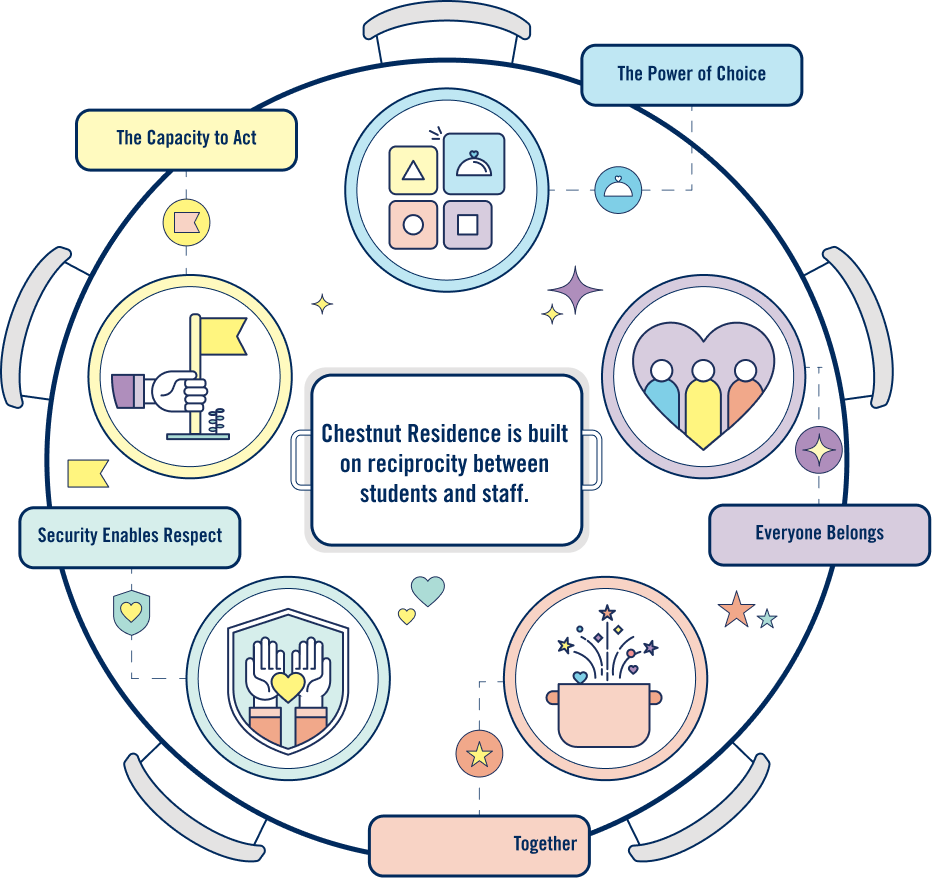The Innovation Hub recently concluded its project, Cultivating Reciprocity at Chestnut Dining Hall, a partnership with Food Services. The Design Researcher Team reflects on the value of co-creation in designing the future of dining at Chestnut.






Written by Amar Krupalija, Kimberly Mak, Reese Halfyard, Larry Afun, Yin Chen Wan (Design Researchers), Eli Rose (Design Research Team Lead)

Our partnership with Food Services began in January 2022 and sprung from the need to hear students’ thoughts about their dining experiences over the course of the pandemic. We aimed to uncover the needs of students through impactful student consultation to co-design for the future of Food Services operations at Chestnut.
We conducted a series of student-led feedback sessions and interviews with current students and staff at Chestnut and developed findings for the future of dining. After collecting and analyzing feedback, we found that the future of dining at Chestnut is built on reciprocity between students and staff. Following, we used a co-creation approach to facilitate opportunities for Chestnut residents and Food Services to collectively imagine the future of Chestnut dining. The co-creation session taught our team about the importance of user-centered research, and we would like to share some of our reflections.
Intentional Idea Generation

The co-creation process is an intentional, open-ended means of generating ideas that can diverge in many directions.
“One thing I found interesting about the co-creation process is idea generation. Whereas mainstream research principles rely on hard, fast frameworks for data collection and ideation, co-creation almost relies on the opposite approach. I found it fascinating that design thinking takes a bottom-up approach where the research questions and solutions are woven together during the co-creation sessions. This strategy of ideation removes the silos that stifle idea generation which makes it excellent for the kind of work that requires innovation.In this way, students were able to respond to carefully crafted open-ended questions that allowed them to freely ideate in all directions.” – Larry Afun
Receiving Feedback vs. Co-Creating
Listening with empathy helped us to understand the needs of Chestnut community members, but co-creating with students helped to build multiple, desirable solutions. As students designing with other students, the co-creation process is very crucial.

“The Food Services project taught me a lot about the power of co-creation. When I first joined the Foods Services team, I had already conducted feedback sessions with the University College project. Coming in with this background knowledge was very beneficial, however, the co-creation sessions were very different. I learned that rather than simply answering questions about their experiences, students could co-create their ideas on our design principles alongside the design team. This collaborative approach provided me with a new perspective to user-centric design research and data collection methods.” – Reese Halfyard
“Getting students at Chestnut Residence to co-create the future state of Chestnut dining is by far the most transformative design thinking experience I have ever witnessed, and I am so proud of everyone who was involved in this work. I started the project by analyzing student feedback which was important to understand the underlying needs. However, when students, who are ultimately users of the Chestnut dining hall, took the lead and ideated solutions, that moment seemed like everything was coming in full circle. Through this work, I believe I have accomplished my mission to empower users to innovate their experiences using design thinking approaches.” – Kimberly Mak
The Impact of Amplifying Student Voices

The co-creation process can be a profitable experience for both participants and facilitators. Ultimately, we are passionate about our work and our role in improving student experiences.
“Our collaboration with Food Services was an enriching experience for me. I thoroughly enjoyed hearing student feedback and was happy to be part of the process of amplifying student voices to university decision-makers. Our team showed great collaborative skills to capitalize on each other’s strengths given these different experience levels.” – Amar Krupalija
“I think the greatest reward is the appreciation from the staff and students of our effort going into the project. As a third-party going into the intersection between the food services staff and students, it always felt intrusive to intervene. However, I was grateful to Food Services staff for supporting our co-creation sessions and our suggestions. During the co-creation sessions, I was also impressed by the creative co-creation ideas from the students, which reflect their desire to improve their experience in the dining hall. At the end of the sessions, I was relieved that both parties showed their appreciation towards each other.” – Yin Chen Wan
Cultivating Reciprocity at Chestnut Dining Hall

In co-creating the future of Chestnut Dining, the ideas generated by Chestnut Residents from the co-creation sessions provided the groundwork to shape the future of Chestnut dining hall. Alongside the Chestnut Residence and Food Services Team, we are excited to see how the co-creation process will impact the future of dining at the Chestnut residence. Curious to learn more about our findings from Food Services? Check out the report to learn about the needs of students and staff at Chestnut.
0 comments on “Project Insights: Cultivating Reciprocity at Chestnut Dining Hall”